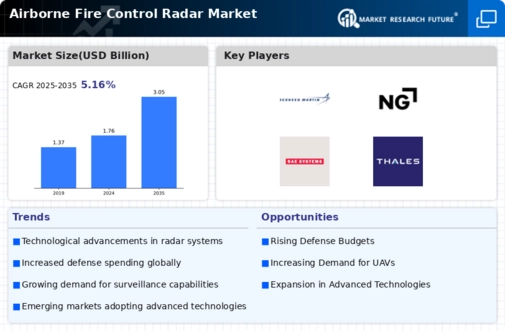Market Growth Projections
The Global Airborne Fire Control Radar Market Industry is poised for substantial growth in the coming years. Projections indicate that the market will reach a value of 1.76 USD Billion in 2024, with an anticipated increase to 3.05 USD Billion by 2035. This growth trajectory reflects a compound annual growth rate of 5.12% from 2025 to 2035. The increasing demand for advanced radar systems, driven by technological advancements and rising defense budgets, is likely to propel the market forward. As nations prioritize military modernization, the airborne fire control radar sector is expected to play a crucial role in shaping future defense strategies.
Increasing Defense Budgets
The Global Airborne Fire Control Radar Market Industry is witnessing a surge in defense budgets across various nations. Countries are prioritizing the modernization of their military capabilities, which includes advanced radar systems. For instance, nations like the United States and India are allocating substantial funds to enhance their aerial surveillance and combat capabilities. This trend is expected to contribute to the market's growth, with projections indicating a market value of 1.76 USD Billion in 2024. As defense budgets continue to rise, the demand for sophisticated airborne fire control radar systems is likely to increase, driving innovation and technological advancements.
Technological Advancements
Technological advancements play a pivotal role in shaping the Global Airborne Fire Control Radar Market Industry. Innovations in radar technology, such as the integration of artificial intelligence and machine learning, enhance the accuracy and efficiency of fire control systems. These advancements enable real-time data processing and improved target identification, which are crucial for modern warfare. As countries invest in next-generation radar systems, the market is projected to grow significantly, reaching an estimated value of 3.05 USD Billion by 2035. The continuous evolution of technology is likely to attract investments and foster competition among key players in the industry.
Rising Geopolitical Tensions
The Global Airborne Fire Control Radar Market Industry is significantly influenced by rising geopolitical tensions worldwide. As nations face increasing security threats, there is a heightened focus on enhancing military readiness and capabilities. Countries in regions such as Eastern Europe and the Asia-Pacific are particularly investing in advanced radar systems to bolster their defense strategies. This trend is expected to drive the market's growth, as governments prioritize the acquisition of sophisticated airborne fire control radar systems to ensure national security. The ongoing geopolitical landscape suggests a sustained demand for these technologies in the coming years.
Emerging Markets and Defense Collaborations
Emerging markets are becoming increasingly important in the Global Airborne Fire Control Radar Market Industry. Countries in regions such as Southeast Asia and the Middle East are forming defense collaborations to enhance their military capabilities. These partnerships often involve technology transfers and joint development programs, leading to the adoption of advanced radar systems. As these nations seek to modernize their armed forces, the demand for airborne fire control radars is likely to rise. This trend not only expands the market but also fosters innovation as local industries collaborate with established defense contractors to develop tailored solutions.
Growing Demand for Surveillance and Reconnaissance
The demand for surveillance and reconnaissance capabilities is a crucial driver of the Global Airborne Fire Control Radar Market Industry. Military operations increasingly rely on accurate and timely intelligence, necessitating advanced radar systems that can provide comprehensive situational awareness. The integration of airborne fire control radars into various platforms, including unmanned aerial vehicles and fighter jets, enhances operational effectiveness. As military forces seek to improve their reconnaissance capabilities, the market is projected to experience a compound annual growth rate of 5.12% from 2025 to 2035. This growth reflects the increasing reliance on advanced radar technologies for strategic military operations.
















Leave a Comment